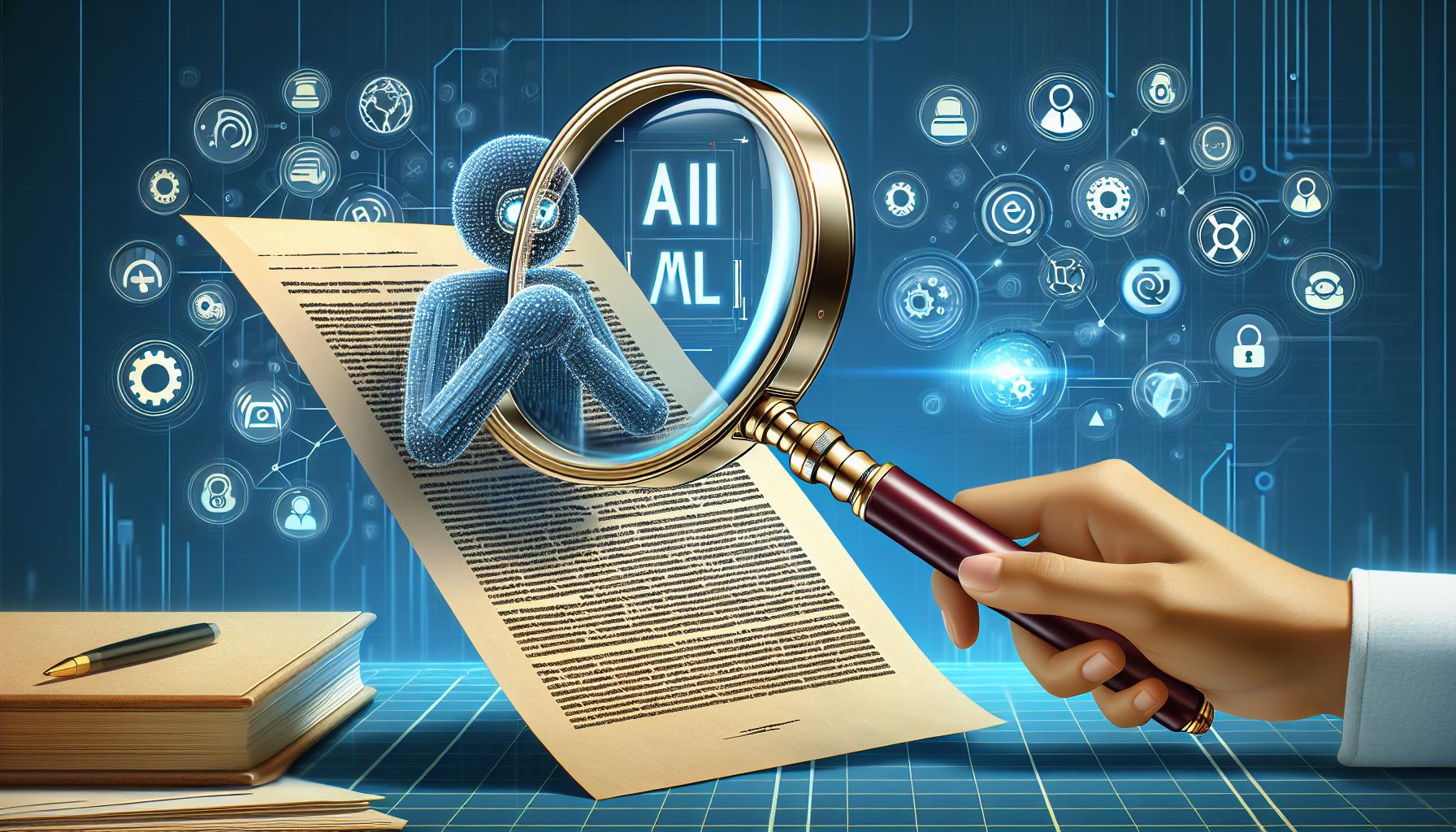Unmasking AI: How Turnitin Detects ChatGPT & Guarantees Academic Integrity
In the digital age, AI-powered tools like ChatGPT are transforming the way we write. But there’s a catch. When it comes to academic integrity, how does Turnitin, the plagiarism detection software, interact with these AI text generators? It’s a question that’s been on the minds of educators and students alike.
Turnitin works by comparing student’s work to a massive database of academic papers, websites, and other resources. But what happens when the text is generated by an AI, like ChatGPT? It’s a fascinating and somewhat complex process. Let’s delve into the mechanics of how Turnitin detects content generated by ChatGPT.
PowerBrain AI Chat App powered by ChatGPT & GPT-4
Download iOS: AI Chat Powered by ChatGPT
Download Android: AI Chat Powered by ChatGPT
Read more on our post about ChatGPT Apps & AI Chat
Key Takeaways
- Turnitin, a plagiarism detection software, operates by comparing a submitted document with a vast database of academic resources. Its detection process relies heavily on a similarity index, which indicates the percentage of matched text from a student’s work to external resources.
- AI-based text generators, like ChatGPT, pose novel challenges to Turnitin’s traditional plagiarism detection process since these tools generate unique and non-reproducible content that is untraceable in Turnitin’s database.
- ChatGPT, a product of OpenAI, uses generative pre trained transformer 3 (GPT-3) to generate contextually appropriate text. It creates content by predicting the next word based on previous inputs, making it difficult for plagiarism detection software to pinpoint duplication.
- The use of AI-generated text raises questions about the assessment of academic integrity. With the onset of AI technologies, the true authorship and origination of content have become blurred, complicating conventional standards of plagiarism detection.
- In response to the challenges posed by AI text generators, Turnitin has evolved its strategies to include natural language processing (NLP), machine learning (ML), and deeper analytical assessment in order to detect potentially AI-generated content.
- The impact of AI on academic integrity is significant. An increasing reliance on AI tools like ChatGPT could lead to the devaluation of critical skills like independent thinking, research, and proper writing techniques. In this context, plagiarism detection tools like Turnitin are not merely to catch wrongdoers but to encourage originality and promote a culture of academic honesty.
Understanding Turnitin’s Detection Process

In making sense of how Turnitin interacts with AI-powered tools like ChatGPT, it’s first necessary to delve into how Turnitin operates. This software, a flag-bearer in plagiarism detection, operates on the basis of comparison and matching. Put, when a document is submitted, Turnitin combs through its extensive database filled with academic resources, papers, and webpages, seeking any material that mirrors the submitted content. What makes Turnitin preferential by many academic institutions is its meticulous algorithm and expansive reach in comparing text.
Formulating a similarity index is key in Turnitin’s detection process. This similarity index reflects the percentage of matched text. For instance, if you have a similarity index of 20%, it means that 20% of your submitted text has been found similar to resources in Turnitin’s database. But fret not; a high similarity index does not always smack of plagiarism; quotations, common phrases, scientific names, and bibliographies can contribute to it. Turnitin allows for a nuanced approach,, and actual human intervention is often required to discern whether these matches tally with plagiarism.
Read more
Professors ChatGPT
Does ChatGPT plagiarize?
xhat GPT
ChatGPT no login
Connect ChatGPT to the internet
ChatGPT no restrictions
However, here comes the catch. When we’re interacting with AI text generators like ChatGPT, we are dealing with a tool that uses machine learning to generate unique pieces of text. It doesn’t merely reproduce, copy, or paraphrase existing content. Instead, it crafts unique responses based on its training. With such a phenomenon, the question is: How does an entity like Turnitin, which relies on matching, detect content generated by AI entities like ChatGPT?
The answer may indeed challenge our conventional understanding of plagiarism and text matching. As we delve into that, remember what we are exploring isn’t just a trivia fact: it’s a new horizon in academic integrity as we move further into the digital age.
Insights into ChatGPT Technology

Understanding the ChatGPT technology is integral to understanding why we’re facing this new challenge in plagiarism detection. ChatGPT is essentially an AI text generator, a product of OpenAI, based on a predictive language model named Generative Pretrained Transformer 3 (GPT-3). It’s trained on an impressive amount of internet text, making it incredibly savvy in generating human-like, contextually appropriate text.
You might be wondering: How does it operate? When you input a prompt, be it a question or a statement, the engine generates text by predicting the next word in a sentence based on the words it has seen before. It’s like playing an endless game of prediction, filling in gaps with statistically probable phrases, sentences, or even whole paragraphs. It’s worth noting that it doesn’t understand the content but statistically predicts the next word.
With its ability to generate unique, coherent, and contextually appropriate text, ChatGPT presents an unparalleled challenge to plagiarism detection engines like Turnitin. Traditionally, Turnitin matches the submitted text to its extensive database for plagiarism detection. But when the submitted work doesn’t match with any existing document in the database but instead is a well-generated text by AI, it becomes a perplexing issue. Identifying such text is intricate!
Furthermore, there’s the question of authorship when it comes to AI-generated text. Humans launch the initial prompt, but the gadget generates the content. So, who’s the actual author? These complexities underline the novel challenges that systems like Turnitin need to rise to in this era of digital evolution.
In the face of AI advances, merely comparing submitted documents to an existing database may not cut it for plagiarism detection. The next section will explore potential adaptations and solutions to these emerging challenges.
Note: Chat GPT, despite its capability, should not be your shortcut to disregard academic honesty or intellectual property. Maintaining our work’s integrity is vital to promote originality in our thoughts and ideas.
Challenges Faced by Turnitin with AI Text Generators
While Turnitin has undeniably become an indispensable tool to maintain academic integrity, there’s no denying it’s increasingly grappling with the challenges posed by AI text generators like ChatGPT.
One of the main hurdles faced by Turnitin with AI is the fundamentally different nature of the generated text. Turnitin’s detection algorithm traditionally banks on matching the text with its vast database. It’s a reliable method when dealing with human-written essays, as the chances of an exact match are high. But with AI-generated text, it becomes a herculean task. It’s because the AI mimics human-like writing, predicting the next word based on a massive range of internet text. The AI does not plagiarize but generates unique but suspiciously perfect content.
The conundrum caused by AI is underlined in this pitfall of traditional detection systems. They primarily function on a proven data-matching model, which AI effectively bypasses. The AI-generated content does not ‘cheat’ in the traditional sense. Instead, it creates something original, albeit not self-created. This disrupts the core algorithm of Turnitin and comparable systems, potentially rendering them less efficient.
But let’s not underestimate the adaptability and resilience of these plagiarism detection systems. They might be facing an uphill battle against smart technologies like ChatGPT, yet it’s all but a stimulation to adapt, align, and reinvent their strategies. And as we know, in the realm of tech, stagnation is never an option, and that’s the real lesson here.
Strategies Employed by Turnitin to Detect ChatGPT Content

In the face of AI advancements, traditional plagiarism detection methods employed by Turnitin aren’t enough. They’ve had to evolve their strategies. Turnitin’s new approach includes a combination of natural language processing, sophisticated machine learning, and detailed analytics.
The first part of their strategy involves Natural Language Processing (NLP). With this approach, Turnitin checks if the grammatical structures and vocabulary usage in submitted texts mirror that of a non-human AI writer. AI text generators like ChatGPT often have telltale signs in their writing style that can be picked up using NLP.
Next, we delve into Machine Learning (ML). It’s another key component that Turnitin uses. It helps detect anomaly patterns that are common in AI-generated content. ML algorithms are trained to identify and learn the nuances of AI-generated text, making these algorithms smarter with each interaction.
Additionally, they’ve increased the depth of their Analytical Assessment. In this step, the submitted content’s writing style, sentence structures, and choice of words undergo intense scrutiny. The analysis enables Turnitin’s system to draw comparisons with typical AI text generation patterns.
In essence, Turnitin’s evolved strategy heavily banks on the abilities of NLP, ML, and analytics to reveal the potentially AI-generated nature of a document. Despite advancements in AI like ChatGPT, Turnitin strives to stay ahead by continuously adapting its detection systems.
Let’s go into how each of these strategies plays out in action.
Implications for Academic Integrity
Now, let’s delve into the significance of this detection game: the implications for academic integrity. As AI technology develops, the temptation for students to exploit such advanced tools, like ChatGPT, might rise significantly. This scenario presents a new challenge to uphold academic integrity in all educational environments, from grade schools to universities.
Unfortunately, the misuse of AI-generated content can be detrimental to students’ growth. On one hand, there’s the risk of plagiarism. If students rely heavily on AI to write assignments, they’re essentially repackaging someone else’s output. This goes against the principles of honesty and authenticity demanded by the academic world.
Let’s break down some additional implications of using AI for writing need to be addressed in schools:
- AI’s impact on Learning progression: When students lean on AI for writing assignments, they may not fully engage in learning. Therefore, they might miss developing critical skills like independent thinking, research, or even proper writing techniques.
- Issue of Originality: AI like ChatGPT derives information from vast datasets, recycling existing content. The borderline between original content and repurposed information becomes blurred, making originality hard to prove.
While Turnitin’s advanced detection mechanisms – combining NLP, ML and Analytical Assessment – work towards maintaining a level playing field, it’s equally important for educational institutions to apply their own preventative measures. These could include cultivating a culture of academic honesty, stressing the importance of quality learning, and teaching students about the consequences of cheating.
Implementing monitoring tools like Turnitin is not just about catching wrongdoers. It’s about encouraging genuine effort, promoting originality, and reinforcing ethical guidelines in every sphere of learning; it’s about ensuring that AI, while an impressive tool, doesn’t replace the critical skills that students need to learn and grow.
Conclusion
It’s clear that AI tools like ChatGPT are a double-edged sword. On one hand, they’re pushing the boundaries of what’s possible in technology. On the other hand, they’re creating new challenges for maintaining academic integrity. As Turnitin evolves its detection capabilities, it’s also up to us, the educators, to step up our game. We must foster an environment that values original thought and effort over easy shortcuts. Let’s use AI to enhance, not hinder, our students’ growth. After all, the goal isn’t just to catch cheaters, but to cultivate learners who don’t feel the need to cheat in the first place.
What challenges does AI-generated content pose to academic integrity?
The risk of students exploiting AI tools such as ChatGPT poses a challenge to maintaining academic honesty. Misuse of such content can lead to plagiarism and impede critical skill development.
What are the major concerns with AI-generated content in education?
The major concerns are the impact on learning progression and the blurred line between original and recycled content. Misuse of AI tools can hinder students’ growth, impede skill development, and lead to plagiarism challenges.
How can educational institutions handle the issues posed by AI-generated content?
Educational institutions can implement measures to prevent misuse of AI, promote advanced detection mechanisms, and reinforce ethical guidelines. Ensuring efforts are genuine, promoting originality and teaching ethical values are crucial countermeasures.
What can individual students do to maintain academic integrity while using AI tools?
Students must use AI tools ethically and responsibly. They should avoid relying solely on generated content and focus on original thoughts and critical thinking. Misuse of AI tools can impede essential skill development.
Is the goal to eliminate the use of AI in academics?
No, the aim is not to eliminate AI use but to ensure it complements, rather than replaces, vital learning skills. AI can prove helpful in presenting new learning techniques and expanding research capabilities.















